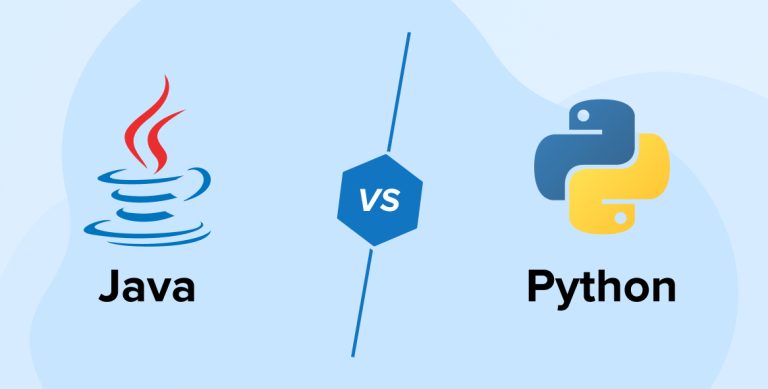
Python and Java are two of the best and most widely used programming languages available. People widely recognize both languages for their cross-platform compatibility and the breadth of their libraries, despite their differences. Each, nevertheless, excels under a different set of circumstances.
The first thing to do while trying to settle on a programming language (if any) is to evaluate the alternatives. As a result, this article on Java Vs Python will evaluate both languages in terms of how well-known they are and how easy they are to pick up.
In addition, we will include a detailed comparison between Java and Python so that you may see it for yourself.
1. Overview of Java
Java has been around since 1995, and it’s both a general purpose programming language and a platform. It has quickly risen to prominence as one of the most popular languages among programmers and web designers since its introduction. We, as a Java development company, have been using Java to develop applications for various business domains.. It’s an Object-oriented language that may be used for a variety of purposes. Java is a faster option since it is a compiled language, while Python is not.
Java, Compiled programming language, has its code automatically translated into machine code. That allows the CPU to run considerably faster and more effectively, and it gives you more control over hardware factors like CPU utilization. C and C++ are further instances of compiled languages, as are Rust, Go, and Haskell.
Web, big data, and Android app development are just some of the many places you’ll find Java at work. It is also gaining popularity in the realms of cloud development and the IoT. Working on large-scale web applications and microservices in Java becomes useful. Many industries use Java to develop their online applications, including healthcare, education, insurance, and government. NASA, Google, and Facebook are just a few of the major corporations now employing Java.
2. Overview of Python
Python has been available to the public since its release to the public in 1991. Guido van Rossum, the language’s creator, has a design philosophy based on making code easy to comprehend. Python’s popularity stems in part from the fact that it is a relatively straightforward programming language to pick up. Interpreters individually interpret every command before executing it..
Python has a more compact syntax than Java, making it better to master and test applications with less time and effort. Instead of needing to compile the whole python program before executing it, you may run it as you type lines into the terminal. Other popular interpreted languages include JavaScript, in addition to Ruby and PHP.
Python allows programmers to use several different approaches to coding at once. Because of its flexibility, it may be employed for more than only object-oriented programming.
The programming community widely uses Java for both server-side and client-side projects. Data scientists and machine learning professionals frequently utilize it because of its many helpful libraries, such as Scikit-learn and Pandas. The likes of Google Search, iRobot, and YouTube would not exist without this language’s involvement in their creation.
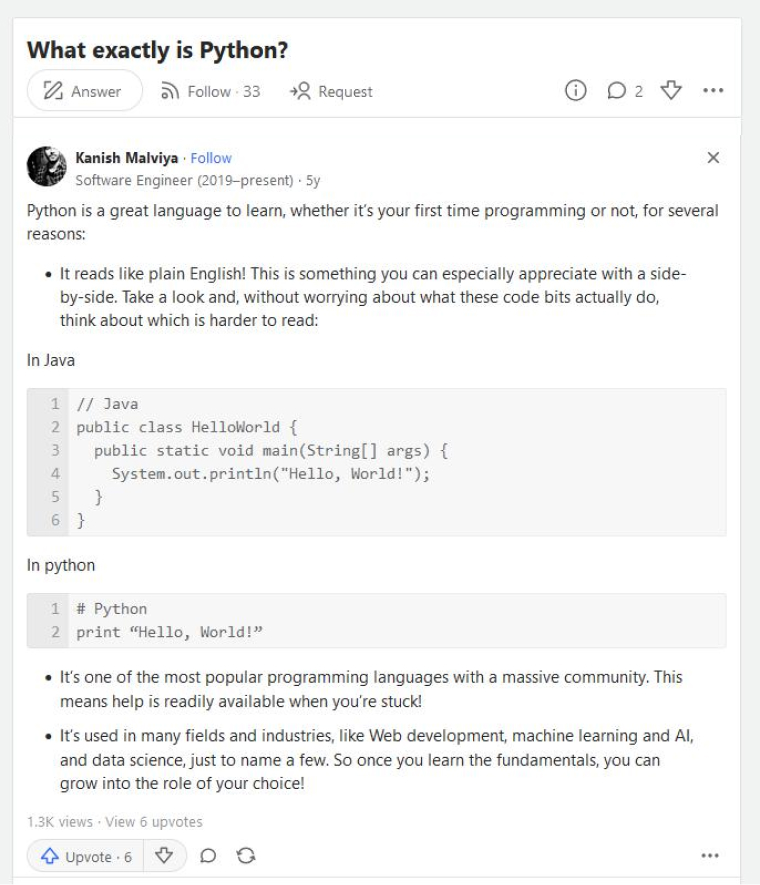
3. Advantages and Disadvantages of Java
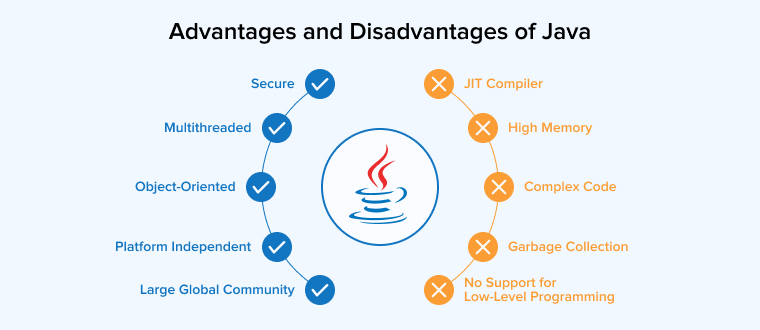
3.1 Advantages of Java
1. It’s Platform-Independent
As long as the machine has the Java Virtual Machine (JVM) platform installed, Java may be used on it. This includes Windows, iOS, Unix, and Linux systems.
2. Object-Oriented Programming Language
It provides a more streamlined method for developing large projects by having you construct classes that contain data and methods and objects that correspond to those classes. Reusing the code and resolving issues more quickly are additional benefits.
3. Multi-Threaded Environment
Java allows for the simultaneous execution of several threads. Multiple threads can execute more quickly and efficiently when they share the same memory space.
4. It’s Secure
Java offers library-level safety together with Java security package and run-time security checks in addition to avoiding the usage of explicit references and running in a virtual machine known as a sandbox to check for unlawful code.
5. It has a Large Global Community
This is useful for learning Java and troubleshooting in general.
3.2 Disadvantages of Java
1. Garbage Collection
Functions like free() and delete(), which allow programmers to influence trash collection, will be unavailable.
2. High Memory and Processing Requirements
The fact that Java is memory-hungry and more verbose than other languages like Python is perhaps its major drawback.
3. The Software is Rather Sluggish Due to the JIT Compiler
The Just In Time (JIT) Compiler of the Java Runtime Environment may trigger code execution to sluggishly progress.
4. Not Possible to Use Java for Low-Level Programming.
It doesn’t help with things like pointers and other low-level programming stuff.
5. Developers have to Deal with Long and Complicated Codes.
Java source code is notoriously difficult to read and comprehend because of its excessive use of complicated and lengthy language. The code’s readability may suffer as a result. Java strives to be more approachable, but at the expense of very complicated programs and lengthy explanations for everything.
4. Advantages and Disadvantages of Python
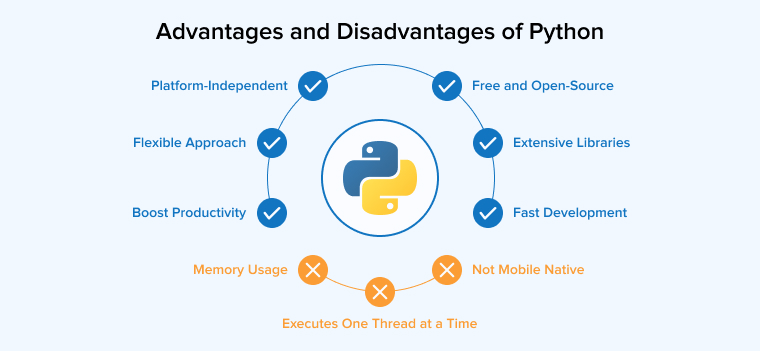
4.1 Advantages of Python
1. It’s Platform-Independent
Like Java, Python is cross-platform and runs on macOS, Windows, and Linux, requiring only a native interpreter for that system.
2. It Allows for Fast Development
Python’s speed and developer-friendliness come from the language’s dynamic typing. Since each piece of code executes independently, it can deal with circumstances and obstacles more quickly by employing asynchronous coding.
3. It Offers Extensive Libraries
The extensive library of Python supports common operations and instructions, and includes code that can be used for a variety of purposes, such as document generation, unit testing, and even CGI.
4. It Offers More Flexible Approach to Programming
Python is flexible and offers python developers with many different programming paradigms to choose from. Not only is this good for programmers who value versatility, but it’s also great for young businesses that may need to pivot quickly.
5. It’s Free and Open-Source
Python is one of the most popular web development languages since it’s free, has a huge and helpful community, and can be downloaded in a matter of minutes.
6. It May Boost Productivity
Python is more efficient than Java, according to NetGuru, owing to its brevity and dynamic typing. It also contains control features and integration tools that help boost the efficiency of software.
4.2 Disadvantages of Python
1. It Only Executes One Thread at a Time
Since Python’s Global Interpreter Lock limits execution to a single thread at a time, multi-threaded CPU-bound programs are likely to run significantly more slowly than they already do. A viable alternative to multithreaded programs is multiprocessing software.
2. It isn’t Mobile Native
You can use Python for mobile applications successfully and simply, but you’re going to have to put in some extra work to locate libraries that provide the essential infrastructure. As an illustration, consider Kivy, which provides a consistent API for developing mobile apps and desktop software that runs on Raspberry PI, Linux, and Windows.
3. It Uses a Large Amount of Memory
This might be a problem if your project requires a large number of concurrently running objects in RAM. If you’re concerned about Python’s memory use per object, switching to NumPy might be a viable remedy.
5. Comparison Parameters of Java vs Python
5.1 Comparing Syntax
Java has been popular with students for a long time because of its straightforward syntax in comparison to languages like C, and because many of Java’s operations, such as memory allocation, execute automatically.
Python, on the other hand, is easier to learn and test in small increments since its syntax is shorter and more like plain English. There is a lot more white space, no requirement to identify data disruptive types, and no brackets, semicolons, or strict naming rules, making it far more legible by humans.
Let’s take an example here:
JAVA
class DemoClass{ public static void main(String[] args) { System.out.println("Hello, World!"); int a = 3, b = 5; int sum = a+b; System.out.println("Sum of a + b is " + sum); } } |
Python
print('Hello, World!') a = 3; b = 5; sum = a + b; print(‘Sum of a + b is’, sum) |
Both the Programs Prints the following output:
Hello, World! Sum of a + b is 8 |
5.2 Performance
Python and Java are considered cross-platform languages because they execute compiled bytecode using virtual machines. Python typically builds at runtime, while Java builds ahead of time and distributes bytecode.
When compared to Python’s typing mechanism, Java’s static syntax makes compilation more quicker and simpler. Despite these drawbacks, code compilation is enhanced by the static-typing syntax since it is more error-proof and platform-specific.
In addition, a Just-in-time (JIT) compiler is available in Java. This mechanism facilitates bytecode compilation into the native processor, facilitating direct invocation of the produced code. The end consequence is improved speed.
Python’s code is processed at compile time (when variables are taken into account). The compilation is less flexible when using a dynamic-typed syntax for the code. Python performs runtime syntax checking, pausing the entire application if an issue is encountered. As a result, both of these can slow down one’s ability to communicate.
5.3 Stability
When writing in Java, the programmer must adhere to rigorous syntax requirements and must declare all variables. More code is produced, reviewed, and fixed as a result. However, there is a bright side to this! It’s possible that the program will be more reliable and less vulnerable to errors because of the extensive evaluation and setup required before it can operate.
This is why many financial institutions and other businesses like Java. In reality, Java is strongly linked to the concept of corporate traditional language. However, Python has also shown that it can easily manage complex programs.
Simply because Java provides dependable software does not indicate that Python is unreliable. In contrast, Java is used by several industry giants, like Android, Docker, and Airbnb. However, Python is also a component of the technology stack at Reddit and Instagram (which uses the Django web framework built in Python).
5.4 Portability
While Python and Java are both portable, Java has a slight advantage due to the Java Virtual Machine (JVM). You can install and execute Python on macOS, Windows, and Linux with only minor changes to the system environment. Python programs require a compiler to translate their source code into the language of the host operating system.
To run Java code, you only need the Java Virtual Machine (JVM); no additional compiler is required. As technology has progressed, JVM has become standard on virtually all handheld and desktop computers. The developer may be assured that the vast majority of their target audience will download and utilize the app.
5.5 Security
Java is more robust than Python, although both are considered safe languages. Java’s powerful login and access control features ensure that the web application is safe. Since Java employs bytecode, the JVM scans generated class files for malicious software whenever the compiler compiles the code.
Python is a straightforward language that is simple to debug. Simpler code reduces the likelihood of future complexity risks and makes debugging simpler. While both Python and Java have strong safeguards in place, Java comes out on top.
5.6 Speed
Python’s straightforwardness, ease of use, and utility make for lightning-fast development. Python is the best option when time is of the essence. On the other hand, Java’s development pace is slower. The development time and size of a team needed for a Java project are both typically higher.
Developing an MVP in Python takes a couple of weeks, while the same task in Java takes months.
5.7 Mobile App Development Compatibility
The term “mobile application development” refers to the practice of creating applications for mobile devices. Language options for creating mobile apps vary from system to system. It just so happens that Java is incredibly efficient in android programs. For creating high-quality mobile apps, the Android SDK provides not just the usual Java libraries but also several of their own.
Mobile app development places a high value on speed. When it comes to creating mobile apps, most programmers do not choose Python due to the fact that it is an interpreted language and so requires more storage space and computational speed at runtime. Python cannot develop native mobile apps, but frameworks like Kivy can be used to create cross-platform apps. Java provides the speed and seamless functionality that is ideal for mobile app frameworks.
5.8 Code Readability & Formatting
Python’s distinctive layout is what sets it apart from other programming languages. It divides the code into sections by using indentation. People widely use Python because it is easy to learn and has excellent source code readability. Python makes it possible to write in only a few lines what would be much more complicated in other languages.
Example:
>>>x = 1 >>> if (x==1) : print(“Hello World”) #Separated by indents |
It’s not always true that Java is the simplest language to learn. Java uses curly brackets to demarcate code segments. Even for basic reasoning, writing understandable code is a labour-intensive process that requires a large number of lines of code.
Example:
class readability_example { public static void main (String[] args) { int a = 1; if(a==1) //Separated by curly braces { System.out.println(“Hello World”); } } } |
5.9. Programming
Backend web development typically employs Python and Java. To put it simply, backend web development is the process of creating a system of programs that are hosted on servers. Both languages provide robust tools for creating websites. Python is the preferred language for efficient web development because of how simple its syntax is. Java’s static typing, however, guarantees that the lines of code are error-free. Two popular web development frameworks written in Python are Flash and Django. Java’s Spring framework is a web application framework. Python’s extensive library and package support have made it a popular choice for usage in the fields of machine learning, AI, and Big Data.
Java’s high performance frameworks have made it the language of choice for game development. For the best possible user experience in a game, the highest possible performance is essential, and Python is not the right tool for the job. Python is used in many different game scenarios, although mostly as a scripting language. Great games can be made with the aid of robust game development engines like JMonkey.
6. Key Differences: Tabular Comparison
| Key Parameter | Java | Python |
|---|---|---|
| Compilation | Compilation is required for use in Java. JVM is the primary tool for this purpose. | Since Python is an interpreted language, it requires meticulous line-by-line inspection of all code. |
| Syntax | The syntax is difficult since it generates problems if semicolons or curly brackets are missing. | The syntax is simple to learn and retain, and it has many similarities to human speech. |
| Security | Java’s advanced identification and access control mechanisms ensure the web app’s continued security. | Python is not as durable as Java. |
| Portability | A Java program may be executed on any computer that has a JVM (Java Virtual Machine) installed. | Python’s portability is poorer than other languages. To run the python code , the local machine must have an interpreter. |
| Stability | It’s possible that the program will be more reliable and less prone to crashes because of the extensive evaluation and setup required before it can operate. | Python is not as reliable as Java despite its rapid development because the syntax is tested at runtime in Python. |
| Performance | Java precompiled programs and passes out copies of the resulting bytecode. When compared to Python’s dynamic-typing syntax, Java’s static-typing syntax makes compilation more quicker and simpler. | Python Code is compiled dynamically, making it less portable to other platforms. |
| Speed | There may be a need for larger development teams and more time for Java-based applications. | Rapid progress since Python is so straightforward and effective. |
| Framework | Many different frameworks may be used with the Java programming language. Common examples are “Spring,” “Blade,” “Hibernate,” etc. | Python lacks Java’s extensive framework support. Some well-known ones are Django and Flask. |
| Learning curve | Java is a complex programming language that requires time and effort to learn and master. | Python is suggested for new programmers because of its accessibility and relative ease of use. |
| Readability | Java can only load up to 10 lines of code at a time from a file. | Python’s file reading code consists of simply two lines. |
| Architecture | The JVM executes Java programs and translates bytecode into machine language. | Python is compiled down to byte code, which can run on any computer. |
| Database Support | Java provides a steady connection. Java has a widely adopted and frequently utilized database connectivity standard called JDBC. | Python provides very rudimentary network access. Python’s JDBC library provides less robust support for accessing databases. Therefore, it sees limited use in business settings. |
| Code example | Class Article {public static void main (String args[]) {System.out.println(“This is the best article on python vs java”);}} | Print in Python:print “This is the article on python vs java” |
| Machine Learning Libraries | Tensorflow, Pytorch | Weka, Mallet, Deeplearning4j, MOA |
7. Java vs Python: Which is Better?
Python Vs. Java: Both languages have matured to the point that they can be relied upon to be continually backed for many years to come. Both will likely remain important in the future, while Python has the most promising growth potential. One of Java’s main advantages will be nullified by Python’s ambitious aspirations to achieve up to 5x performance increases.
Java, however, has stood the test of time and become an integral part of the workflows of numerous development teams worldwide.
8. Conclusion
Both languages have established healthy communities that give them a good chance of lasting for the long haul. Choose any language with confidence; they both have their uses.
Python’s dynamic typing may or may not be superior to Java’s static approach, depending on who you ask. The topic of which model is better for you and your team has been debated long before any of them were ever created. Java’s higher performance and security may sway you, or perhaps Python’s more streamlined syntax and the lower learning curve will win you over. Neither Java nor Python is optimized for latency-critical applications, although Java is significantly quicker.
Apart from pros and cons of Java, it is still the best option for projects that need to adhere to strict security standards, or for those that require mobile or business apps. When it comes to machine learning, data science, or just getting up to speed quickly, Python is your best bet.


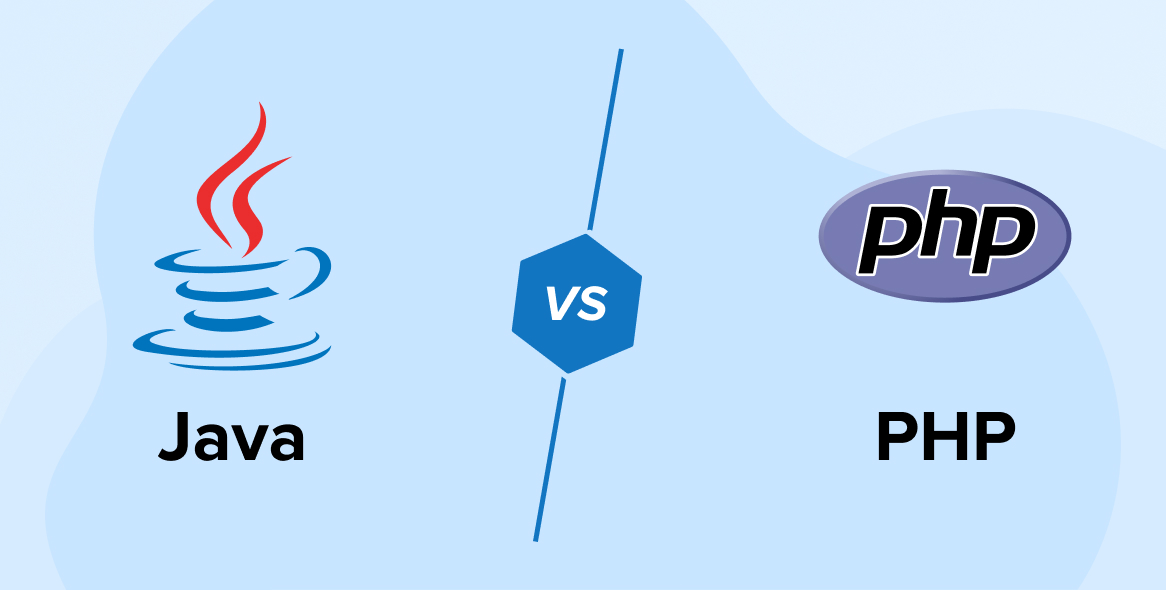
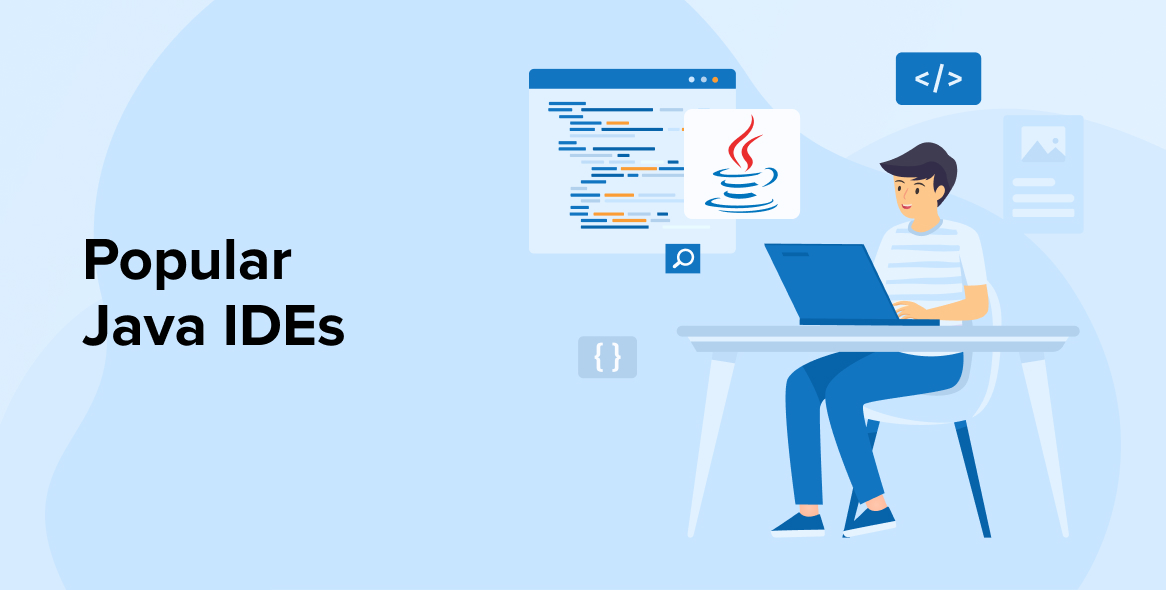


This is a great comparison of Java and Python! It's valuable to see the pros and cons of each language laid out clearly. Now I have a better understanding of which language might be a better fit for my next project.